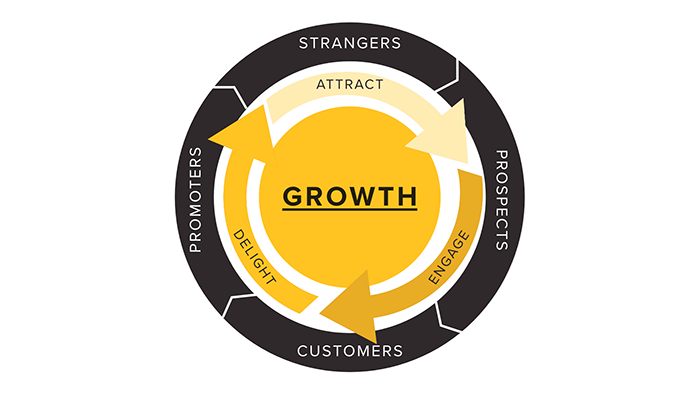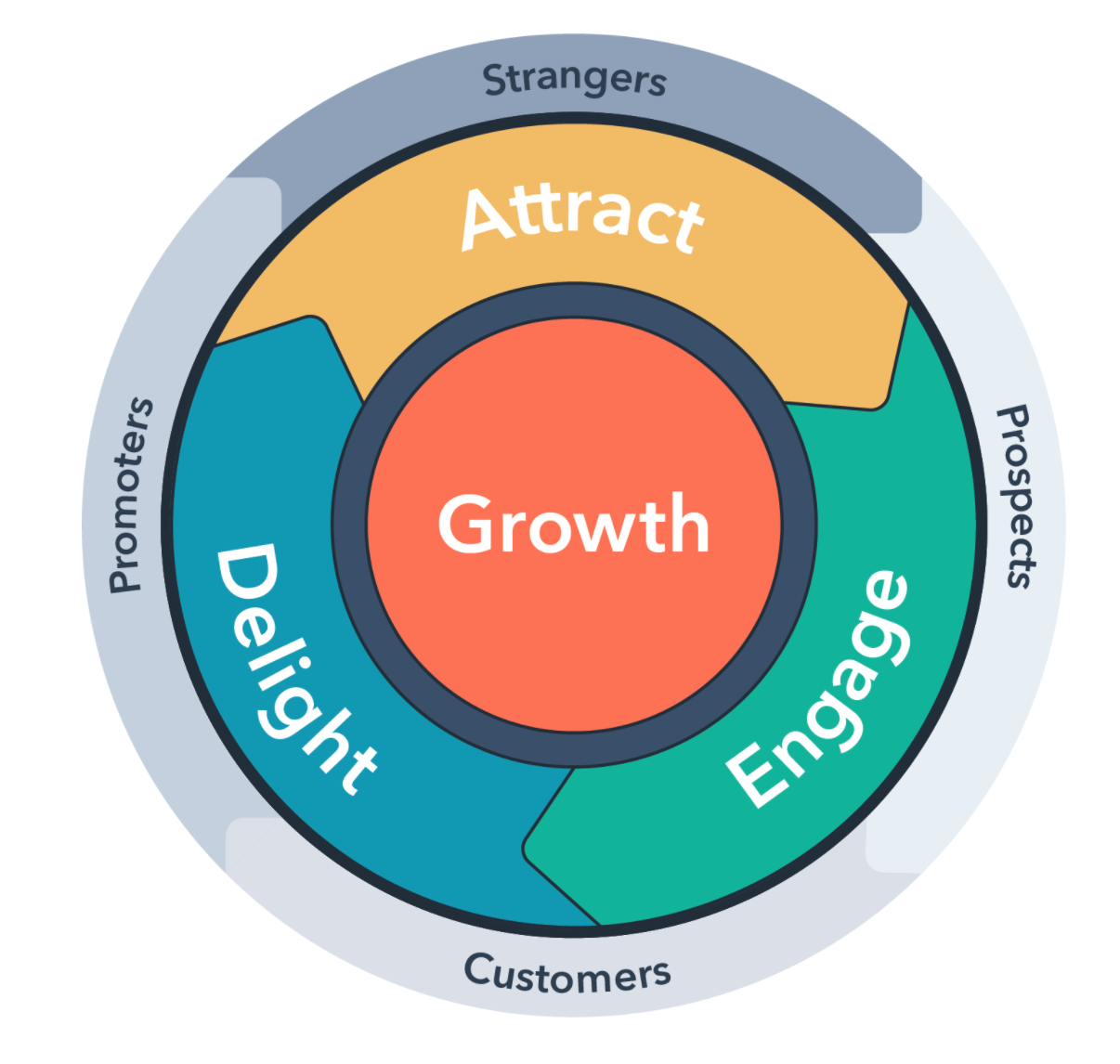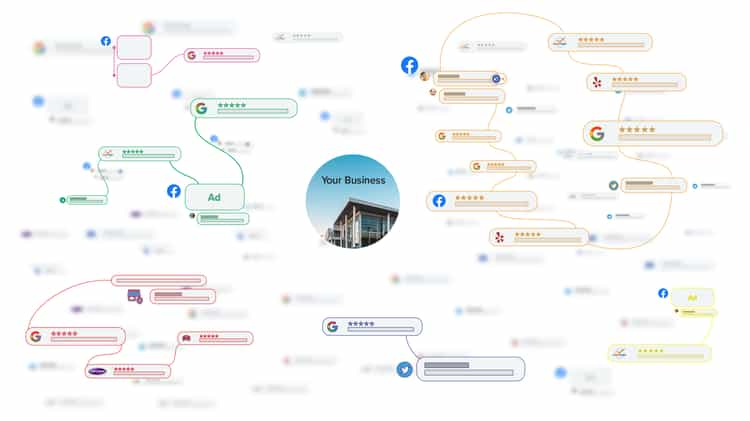Learn how Hubspot's Flywheel marketing model for growth can be powered by reputation management and complimented by content and the Brand Mosaic concept.

*Originally posted on June 22nd, 2021 and updated on July 15th, 2024.
Consumer trust is at an all-time low. Customers are more skeptical, knowledgeable, and demanding than ever before.
They expect businesses to prioritize long-term relationships and values over short-term gains. When companies fail to meet these expectations, customers quickly spread the word, impacting the business's reputation and growth.
Havas Media Group recently reported that only 47% of global brands are seen as trustworthy, with 71% of consumers stating they have little faith that brands will deliver on their promises. It's not outrageous to say we’ve entered the age of cynicism, which requires businesses to double their marketing efforts and prioritize the customer experience above all else.
Once a valuable source of leads, in general Facebook is no longer relied on as a steady source of new business. On top of that, acquisition costs are on the rise. So, as a business, what can you do to adapt to the changing times and implement effective marketing strategies that attract new customers and delight existing ones?
You’re likely familiar with the traditional funnel that guides prospects from marketing to sales to becoming a customer. While it does a great job of tracking customers through the acquisition phase, it does nothing to harness the power of your existing customers to fuel growth after the initial sale.
Identifying the shortcomings of the funnel, HubSpot developed the flywheel, a growth model that fundamentally views the customer as the process accelerant, rather than the byproduct.
HubSpot's Flywheel is defined as a business model that emphasizes the importance of customer satisfaction and retention in driving growth. Unlike the traditional sales funnel, which focuses on the linear process of attracting, converting, and closing leads, the flywheel model views the customer journey as a continuous cycle. This approach aims to create momentum by leveraging happy customers to drive referrals and repeat business.
Let’s take a closer look at the differences between the funnel and flywheel, and building on that, outline how reviews, reputation management tactics and a managed Google review service can harness the positive sentiment developed with the flywheel to attract new prospects.

Credit: Hubspot
In a recent interview with the Sydney Morning Herald, Brian Halligan, CEO of HubSpot, said, “People don’t trust anyone or anything anymore. We don’t trust our institutions, we don’t trust our companies, we don’t trust our social network. There's this crisis of trust going on". In order to elevate the customer experience and establish that elusive trust, Halligan argues that relationship-based marketing, like the flywheel and developing a brand mosaic, needs to be at the core of a company’s growth plans.
When the flywheel is utilized properly, customers become your company’s growth accelerant. The funnel views customers as the end output of the marketing process, but the flywheel puts focus beyond the sale, to both engage and delight customers after the buying cycle is complete.
How can your company power the flywheel and turn prospective customers into brand advocates? Focusing on online reviews and cultivating a brand mosaic is a great place to start.
Reviews enable you to harness the positive sentiment developed via the flywheel and share that feedback through word of mouth, search, social media, and the web.
Reviews act as a natural way for happy customers to attract new customers. Ideally, those new customers will go on to leave positive reviews, and the flywheel keeps on spinning.
Delighting customers can turn them into promoters of your brand. And promoters of your brand will attract new customers. Your happy buyers want to help you grow, and one of the best ways they can do that is by leaving reviews.
In the last year, 77% of consumers shared positive experiences with their friends or on social media/review sites. That’s a good chunk of consumers who were eager to share their glowing feedback of a company, whether it was online or offline.
Another stat: 72% of consumers say that positive reviews make them trust a business more. In the low-trust environment we live in, this is a notable win.
Not only do online reviews inform prospective customers’ purchasing decisions, but they also act as consumer-generated content for your business. Take some of your positive reviews and share them on social media, bake them into a case study, or display them on the front page of your website. Customers will take time to read what people are saying about your business, so why not use that invaluable sentiment to your advantage and use feedback as marketing collateral?
Powering the flywheel and driving advocacy is all about generating momentum. How fast the wheel spins and the amount of friction it encounters depends on how solid a customer experience you’re delivering.
The speed of your flywheel can increase when you focus your efforts on areas that have the biggest impact on the customer experience. These areas can include inbound marketing, frictionless selling, a customer referral program, paid advertising, and investing in your customer service team.
On the flip side, the speed of your flywheel can be hindered when opposing forces are counteracting your positive efforts. Friction can be generated as a result of inefficient internal processes, lack of communication between teams, or misalignment between your customers and your employees.

An effective way to both generate momentum and reduce friction is to serve up quality, relevant content on a consistent basis. This could come in the form of blog posts, whitepapers, case studies, guides, or social posts that educate your target audience and provide answers to their most pressing questions.
When generating content, keep in mind that your goal is to produce material that resonates with prospective customers and builds trust while establishing you as a true authority. You want to earn people’s attention, not steal it, so what you create should be based on addressing your target audience’s pain points and providing answers to their most pressing questions.
Your content should feel natural, organic and ultimately work to inform others about what your business is all about. Whether you want to focus your efforts on social, blogs, infographics, or emails, ensure that what you put out into the world is created with the customers’ best interests in mind. Prioritizing the customers' issues in your content is a central component of inbound marketing. And strengthening your approach to inbound marketing is an effective way to power your flywheel and keep it spinning.
Another benefit of content generation has to do with developing your brand mosaic. The more content you create, the more defined and complete your brand mosaic will become. If you’re scratching your head wondering what a brand mosaic is, we’ve got you covered.
The definition of a "brand mosaic" (or mosaic branding) refers to a marketing concept where a brand is represented by a multifaceted and diverse collection of elements, much like the pieces of a mosaic art form. And that a brand is not defined by a single, monolithic identity, but rather by a combination of attributes, experiences, and perceptions - that together create a comprehensive representation.
And no two people will experience your mosaic in the same way.

People who interact with your brand will experience it in a variety of different ways. Consider all of the varying content interactions your brand has with consumers.
Surely (unless you have some serious superfans), most customers won’t digest every piece of content you put out into the world. They’ll most likely interact with bits and pieces here and there. This creates a web of disparate experiences that your audience has when engaging with your brand.
In order to ensure each unique experience a customer has with your brand is enough to get them in the door, publish a wide variety of content that, on its own, is enough to attract and engage prospective customers. Reputation management enables you to fill out the mosaic, but possibly more importantly, it gives your company a toolset to gently massage and shape your mosaic into an asset that consistently brings in new customers.
At the intersection of reputation management and advocacy marketing is Widewail’s integration with HubSpot. As online reputation experts, we enable clients to deliver the very best customer experience to their audience through automated tools backed by people-powered processes. Our integration with HubSpot streamlines the review invitation process, resulting in increased review volume, frequency, and quality.
Powering your flywheel and strengthening your advocacy marketing efforts starts with finding the right partners.
Read the Widewail & Hubspot integration overview to learn more.
I’m the Director of Marketing here at Widewail, as well as a husband and new dad outside the office. I'm in Vermont by way of Boston, where I grew the CarGurus YouTube channel from 0 to 100k subscribers. I love the outdoors and hate to be hot, so I’m doing just fine in the arctic Vermont we call home. Fun fact: I met my wife on the shuttle bus at Baltimore airport. Thanks for reading Widewail’s content!
Bite-sized, to-the-point, trend-driven local marketing stories and tactics.
U3GM Blog Post Comments